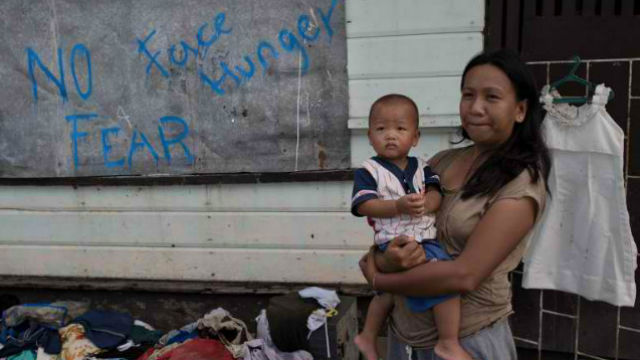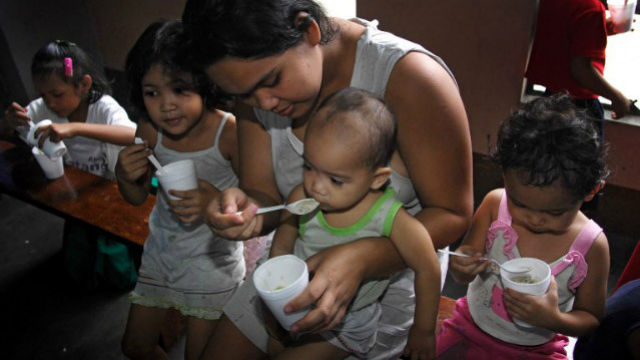SUMMARY
This is AI generated summarization, which may have errors. For context, always refer to the full article.

MANILA, Philippines – Women and girls account for around 60% of the world’s chronically hungry, the World Food Programme (WFP) estimated.
This is despite the fact that women worldwide, according to the Food and Agriculture Organization (FAO), produce more than half of our grown food.
FAO observed that women are more likely to go hungry because of their unequal access to education, employment, resources and social services. Some societies also consider women weak, deeming them unfit for certain tasks.
Where does this leave women? History would answer: at home, with the kids.
In the Philippines, women provide 84% of the total “household time allocated to child care,” the International Labor Organization (ILO) reported. This arrangement can constrain her participation in paid work.
Isolating a woman to domestic roles not only compromises her economic independence, but also her autonomy over deciding for her own body, health, and basically – her life.
This can push women further into poverty, potentially increasing their vulnerability to hunger and other health risks.
In the Philippines, women (11.2 million) – next to children (12.4 million) – have the 2nd largest magnitude of poor among the basic sectors, according to the latest data from the National Statistical Coordination Board (NSCB) in 2009.
Gender inequality, food insecurity
Gender equality contributes to food security, FAO and the Asian Development Bank (ADB) suggested in their 2013 joint report.
The report argued that limiting a woman’s education and employment opportunities “weakens her bargaining position within the family” – mothers and daughters having little or no voice in family decisions. This can also translate to “differential feeding and caregiving practices favoring men” in the family.
FAO and ADB promoted women empowerment as a “tool against hunger.”
WFP, on the other hand, views gender inequality not only as a major cause of hunger and poverty, but also an effect of it.
If women and men are deprived of education, both of them will not fully understand equality. Men will disrespect women, while the latter will conform – since both parties are unaware of their rights and responsibilities.
Hunger may also contribute to the persistence of inequality within families. Among poor and food-insecure households, it is common for mothers to consume the least since they prioritize their children.
“Isusubo ko na lang, ibibigay ko pa,” most mothers would say. (Rather than eat myself, I’d rather give or share it.)
Meanwhile, some women make sure their husbands get the biggest share since they are the ones who earn. In some instances, sons are also favored – having a bearing on the nutritional status of girls.
The Philippines ranked 5th out of 136 countries in terms of gender equality in economics, health, politics, and education, according to the 2013 Global Gender Gap Report.
Despite the developments throughout the years, some might argue that women – especially the poor and disadvantaged – are still subjected to multiple layers of discrimination in the Philippines and elsewhere.
Domestication of women
Princess Nemenzo, sociopolitical activist and feminist, argued that Filipino women remain vulnerable to hunger and poverty due to the many conditions working against them.
One of them is the domestication of women.
“Look at the kinds of livelihood made available to women. Dapat matanggal ang stereotyping. This isolates women to low-paying domesticated tasks. Women should recognize and protect their economic autonomy,” Nemenzo said.
These stereotypes include limiting women to secretarial jobs, domestic work, entertainment, hospitality, and service industries.
The over-emphasis on women’s “caring nature” has the tendency to dismiss their other abilities, opportunities, and needs.
“Pero binabasag na nang unti-unti ang stereotypes. But generally, jobs connected to domestic chores are still women’s,” Nemenzo added. She urged the government to provide the support women are entitled to, and for both women and men to demand for what is rightfully theirs – freedom from gender roles.
The Philippine Commission on Women (PCW) said that the “feminization of poverty and discrimination mean that the most vulnerable and marginalized groups tend to end up in the informal economy.”
Jobs in the informal sector are low-paying and insecure (i.e., vendors, beauticians, laundress, barkers). Women in the informal economy lack social protection and work benefits; hence they are at “high risk in times of illness, disability, work injury, maternity, unemployment, and old age,” PCW emphasized.
Their income is compromised once they or their children get sick, or once they get pregnant. For many women, if they stop working, it can also mean they stop eating.
“Women are concentrated in insecure jobs in the informal sector with low income and few rights; they tend to have few skills and only basic education. They are the first to be fired,” UN Women explained.
In the Philippines, women make up 84% of all domestic workers.
Although domestic helpers endure laborious tasks and long working hours, their services are undervalued and underpaid. “On average, domestic workers are the lowest paid among wage workers,” ILO noted.
Most live under the same roof as their employers, and experience maltreatment and hunger.
Unpaid work

ILO reported that in 2011, 31% of working-age Filipino women said they were unable to join the labor force job due to household and family obligations. Only 3% of men reported the same experience.
PCW observed that women are more likely to “move in and out” of the labor force because they are divided between demands from home and the need to generate income.
As a result, women end up tolerating poor and exploitative work arrangements just so they can fulfill both their “productive and reproductive work.” The latter refers to women’s unpaid and undervalued work – household tasks and childrearing.
This kind of work goes beyond the regular 9 am-5 pm shift; in a way, a woman’s work never ends.
Since most women spend long hours on unpaid or invisible work, they must adjust their “paid work” around the latter’s schedule – potentially burdening women with additional physical, mental, and emotional stress.
A 2013 NSCB study showed that if women’s unpaid hours were accounted for, women’s reported share in the Philippine Gross Domestic Product (GDP) would increase from 39% to 44% from 2000-2009.
The Philippine gender wage gap is only 3%, at women’s advantage; however, this is only based on the daily wage. If we take into account the fact that women spend fewer time at “paid work” than men – due to domestic constraints – the actual gender wage gap could range from 23%-30%, ILO explained.
Hunger is not a stand-alone problem, but a multi-faceted issue faced by both women and men. Employment, education, and gender equality are among the many factors involved in the hunger dilemma.
However, history has shown that the world has never been completely fair to women. The reality is that most of the world’s unfed mouths are either those of women or those fed by women.
Borrowing and tweaking George Orwell’s famous quote from The Animal Farm, “Perhaps all people are equal, but some people are more equal than others.” – Rappler.com
Add a comment
How does this make you feel?
There are no comments yet. Add your comment to start the conversation.